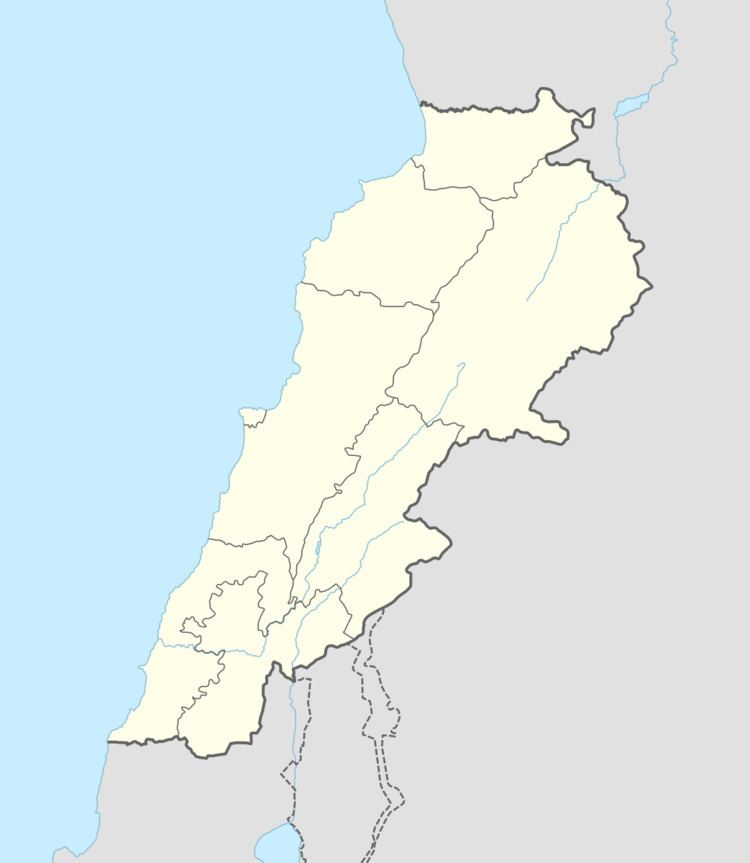Highest elevation 700 m (2,300 ft) Time zone EET (UTC+2) Area code +961 | Lowest elevation 550 m (1,800 ft) Local time Thursday 10:25 AM | |
 | ||
Weather 14°C, Wind W at 8 km/h, 60% Humidity | ||
Lebanon s roumieh prison iron fist policy against a jihadist hub
Roumieh is a village north-east of Beirut in Lebanon. Surrounded by pine-forested hills, Roumieh is a 5/10-minute drive from the coast. Roumieh is known as a pleasant, picturesque small mountain town with many gardens.
Contents
- Lebanon s roumieh prison iron fist policy against a jihadist hub
- Map of Roumieh Lebanon
- Public institutions
- Agriculture
- Climate
- Demographics
- Topography
- History and People
- Education
- References
Map of Roumieh, Lebanon
Public institutions
Agriculture
In addition to pine forests; vineyards, fig orchards, olive trees and thyme grow in abundance. The village is well known for the Arak it produces; to the extent that some of the local residents claim that it is some of the best made in the country. A well known producer is the legendary Doumit who is the son of the late Hanna Doumit, the beloved shopkeeper.
Climate
Roumieh is characterized by a temperate climate, including dry summers, rainy winters, and transitional fall and spring seasons. It is located 550 to 700 meters above sea level.
Demographics
The village's community is mainly constituted of Maronite Catholics and Greek Catholic, but also Greek Orthodox and Armenian Orthodox. It is populated by 5000 residents.
Topography
The word "Roumieh" comes from Aramaic, meaning "hills" and refers to this characterising feature of the local terrain. This is understandable when one sees the "bumpy" pinetree-ridden hills in the pastures of the village.
Like all Lebanese mountain villages, Roumieh is marked with very beautiful terraces (Jleleh), designed to optimise the use of its land for agriculture and horticulture. Indeed, as cited above, some of the crops grown in Roumieh are exceptionally good given that the community had ceased to be an agrarian one nearly half a century ago.
There used to be several natural streams (Ain) that surfaced in the village which was a good source of water for the village community. However, due to disorganised and sporadic construction in some of the marginal parts of town, most of these have disappeared; and there is only one that remains properly functional, at the fountain in the centre of the village. The square surrounding the fountain has always been very pretty but has now been somewhat damaged by political slogan graffiti and the sticking of political propaganda posters on its premises.
One can find some very pretty traditional Lebanese houses (pyramidal red brick roofs, white or sand stone walls with overlooking balconies and verandas shaped with arches in the old Levantine style) in Roumieh. Examples of this are some surrounding the Saydeh Church, but also others in the Naas and Haret el Tahta and Fawka neighbourhoods.
History and People
Whilst the village itself is quite old (founded circa 1500), the 20th Century saw the village coming to a more prominent role in the area. With the diaspora towards the West and Latin America ongoing, the village acquired wealth, and relatively to other similar villages, its inhabitants became increasingly educated (partially thanks to the proximity of both the Capital and its institutions). Lebanon has been plagued by sectarian violence since the 19th century, when Maronite and Druze communities where fighting in the mountains. More recently, the civil war that erupted in 1975 was the scene of severe sectarian tensions.
Although Roumieh is known for its people quarrelling over politics and even fighting from time to time, it is a tight-knit community that has survived the most divisive horrors of the Lebanese Civil War and the ongoing political turmoil. The village's diversity of opinions underlines its development that outdoes by far other villages in the area. The villagers may strongly disagree with each other on matters of politics, and given how seriously they take this, they may even go as far as being hostile to each other; however, it remains the community that its forefathers built and will remain so thanks to some outstanding members who have been known to put family and village before anything else. Lebanese villages have always been collectivistic societies. Lebanese villagers have always put the family in the first place, followed by the individual. The family, the church and the community at large dictate group patterns in Lebanese villages.
Education
Lycée Charlemagne, a French international school, and Mar Doumit Antonine Sisters College, a trilingual school, are located in Roumieh.
